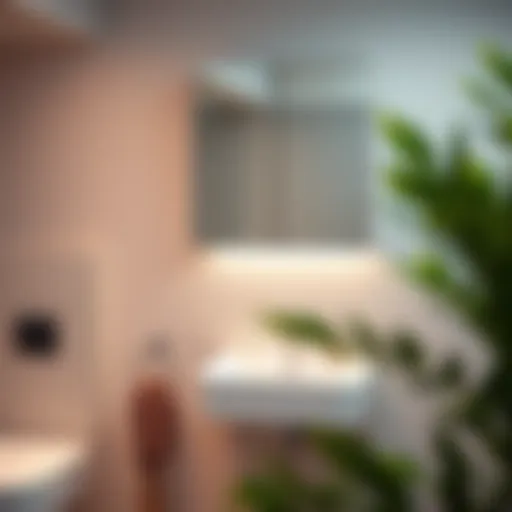Exploring E26 Globe Bulbs: Design and Functionality


Intro
Lighting plays a critical role in shaping the atmosphere and functionality of spaces, both at home and in business. Among the myriad of lighting options available, E26 globe bulbs offer a unique blend of aesthetics and practicality that's hard to beat. E26 globe bulbs, well-known for their distinctive rounded shape and versatile design, have carved their niche in the lighting industry. The appeal of these bulbs extends beyond mere illumination; they offer a distinctive visual element that complements modern interiors. In this article, we will explore various aspects of E26 globe bulbs, bringing to light aspects of their design trends, functionality, energy efficiency, and applications.
Design Trends
Lighting design is continuously evolving, with trends emerging that push the boundaries of creativity and innovation. E26 globe bulbs stand at the fore of this evolution.
Contemporary Styles
Contemporary styles reflect a shift in design philosophy, focusing on simplicity and minimalism. The E26 globe bulb is often utilized in settings that favor clean lines and understated elements. With their soft curves, globe bulbs can deliver a warmth that stark geometric shapes sometimes lack.
For instance, consider a dining area adorned with a cluster of E26 globe bulbs suspended at varying heights above a simple wooden table. This arrangement not only throws soft light across the space but also serves as a striking visual centerpiece. Some popular contemporary styles of E26 globe bulbs include:
- Industrial: E26 bulbs featuring exposed filaments that evoke a raw, urban vibe.
- Mid-Century Modern: Sleek, minimalist designs characterized by a rich finish, often in brass or matte black.
- Scandinavian: Simple and functional, with an emphasis on light colors that enhance natural light.
Color Palettes and Materials
The choice of color and materials used in E26 globe bulbs can dramatically affect the overall aesthetic of a space. While traditional globe bulbs often come in clear glass, modern designs have diversified to feature frosted, tinted, or even colored glass.
A frosted finish can diffuse light beautifully, creating a soft, even glow throughout a room, while tinted hues like amber or green also add an artistic touch. In addition, materials are key to achieving the desired look. Metal bases in brushed nickel or vintage bronze add to the overall feel of sophistication. Choosing the right combination of color and materials often leads to a more harmonious design that resonates with the space.
"Lighting has a way of defining spaces, echoing the sentiments and moods we wish to portray."
Functional Solutions
While aesthetics are vital, the functionality of E26 globe bulbs cannot be overlooked. They serve various roles in enhancing space utility and comfort.
Ergonomic Furniture
In areas where optimal function is key, such as offices or reading nooks, E26 globe bulbs work wonders when paired with ergonomic furniture. Adjustable desks and comfortable seating can benefit from the soft, ambient light provided by globe bulbs, reducing glare and eye strain. The right lighting helps create an environment conducive to productivity and relaxation.
Space Optimization Tips
E26 globe bulbs can be strategically placed to optimize spaces effectively. Whether it's highlighting architectural features or creating cozy corners, these bulbs can adjust to the spatial needs. Here are some tips for utilizing E26 globe bulbs effectively:
- Layered Lighting: Combine E26 globe bulbs with other forms of lighting, such as floor lamps or table lamps.
- Dimmer Switches: Incorporate dimmer switches to control the intensity of light and adapt to different time of day.
- Placement: Install bulbs at various levels to create depth and interest in a room's layout.
In summary, understanding the design trends, functionality, and applications of E26 globe bulbs can help transform spaces from mundane to magical. They not only serve as an essential part of interior design but also allow for creativity and personal expression in a functional context.
Prolusion to E26 Globe Bulbs
The world of lighting is nuanced and rich, with choices that can dramatically influence the look and feel of a space. E26 globe bulbs occupy a noteworthy place within this spectrum, blending functionality with design aesthetics in ways that are often overlooked. These bulbs aren't just about illumination; they also serve as a statement piece that can elevate the ambiance of both residential and commercial settings. Providing a thorough understanding of E26 globe bulbs—what they are, their characteristics, and their historical development—sets the stage for assessing their applications and advantages.
Definition and Characteristics
E26 globe bulbs are generally recognized by their distinctive spherical shape and the E26 base type, which denotes a screw-in fitting with a diameter of 26 millimeters. This base is prevalent in North America and ensures compatibility with a vast number of fixtures. These bulbs come in a variety of designs, including clear, frosted, and colored options. The light emitted can range from warm to cool tones, greatly impacting the mood of a space.
Their design is not merely ornamental. The globe shape allows for a more dispersed light, casting a welcoming glow that helps to create a cozy atmosphere. Furthermore, their specifications often include energy-efficient options, making them a solid choice for consumers who are increasingly eco-conscious.
Historical Context of Globe Bulbs
To truly appreciate E26 globe bulbs, one should explore their origins. Globe bulbs have been around since the early 20th century, gaining prominence during the rise of electric lighting in urban environments. Initially, incandescent versions were the norm, providing a warmer light that many found comforting. Over the years, as technology advanced, the introduction of LED options transformed the market entirely.
These bulbs have become staples in various settings, from chic loft apartments to trendy retail stores. Their evolution from simply functional to being a centerpiece of interior design reflects larger trends in how we view lighting today. Understanding this historical context not only highlights the bulb's versatility but also underlines its importance as a vital element in modern architecture and design.
The ongoing evolution of lighting technology makes the E26 globe bulb a contemporary icon, blending utility and aesthetics seamlessly.
As this examination unfolds, each aspect of E26 globe bulbs will be scrutinized—delving into their specifications, exploring their design possibilities, examining their energy efficiency, and discussing their various applications in everyday life. This holistic view is essential for anyone involved in design or architecture, ensuring that informed lighting choices are made.
The E26 Socket Explained
The E26 socket plays a pivotal role in the world of globe bulbs, acting as the backbone for their widespread use in modern lighting solutions. Understanding this socket is not just a technical necessity but also an insight into the practical aspects of lighting design and application. With its simple yet effective design, the E26 base is a choice that resonates well with numerous consumers and designers alike. Its standardization across many bulbs ensures compatibility, making it easier for users to transition between different lighting solutions without a hassle.
Understanding the E26 Base
The E26 base, also known as the Edison screw base, is a screw-in light bulb socket that is 26 millimeters in diameter. Originally designed by Thomas Edison, the E26 socket has gained popularity due to its user-friendly and versatile design. When one thinks about the E26, a few defining characteristics come to mind:


- Universality: The E26 is the go-to choice for many types of lighting, from incandescent to LED.
- Ease of Installation: Installing an E26 bulb is as easy as screw it in; no specialized tools or expertise required.
- Widespread Availability: Because of its commonality, E26 bulbs can be easily found in stores or online, providing customers with a plethora of options.
Since it serves as a standard base in many North American households, understanding its intricacies can provide benefits not only in purchasing decisions but also in any broader lighting strategy.
Comparative Analysis of Socket Types
When assessing the E26 socket in the context of other socket types, one must look at its versatility and compatibility with different bulb designs. The comparison usually centers around various socket types available today, but it’s critical to weigh the choices each provides.
Compatibility with Other Bases
The E26 base stands out because of its compatibility with various types of bulbs and fixtures, making it a widely preferred option. For instance, E27 sockets, which are slightly larger, can often accommodate E26 bulbs, and this is a key factor that contributes to its appeal. This adaptability allows homeowners and designers to utilize E26 bulbs in different settings without being constrained to specific equipment.
- Versatile Use: Whether integrating into a vintage-style lamp or a modern fixture, the E26 can flexibly fit into multiple environments.
- Reduced Maintenance: Using a single type of socket reduces the complexity of maintaining a home lighting system. No need to stock various replacements – just keep a few E26 bulbs on hand.
In this light, the E26’s ability to be compatible with other bases makes it a smart choice for both consumers and retailers, enhancing user satisfaction with its simplicity.
Advantages Over Other Types
Evaluating the advantages the E26 base has over other socket types can reveal why it has become the industry standard. One key characteristic lies in its design simplicity and straightforward installation process. Here are a few reasons why many still favor the E26:
- Affordability: Generally, E26 bulbs tend to be less expensive than their counterparts that require specialized sockets.
- Availability: That convenience translates into a much broader availability in various stores, making it easy for consumers to find what they need without searching far and wide.
- Durability: The robust nature of the screw-in design adds a level of durability that less common socket types may lack, ensuring longer-lasting performance.
This analysis emphasizes that for general lighting solutions, the E26 socket presents itself as a practical, economical, and dependable option, facilitating ease of use across various lighting applications.
Design and Aesthetics
The design and aesthetics of E26 globe bulbs play a pivotal role in shaping both functional and visual aspects of a space. In today’s diverse lighting market, the marriage of form and function has become essential, especially in settings where ambience and style are pivotal. With the rise of interior design trends that prioritize mood and atmosphere, E26 globe bulbs have emerged as prominent choices not just for their utility, but for their ability to enhance the overall decor.
Varieties of Globe Bulb Designs
When delving into the varieties of globe bulb designs, it’s clear that these bulbs come in a stunning array of shapes, sizes, and finishes. The classic spherical design is often favored, providing a clean, minimalist look that suits many environments. However, there are also unique twists, like elongated or elliptical shapes that can serve as statement pieces.
Moreover, options such as frosted or clear glass finishes create different effects. Clear globe bulbs, for instance, are perfect for vintage-style settings, allowing the intricate filament designs to be showcased. In contrast, frosted bulbs emit a softer, diffused glow, ideal for creating warm, inviting atmospheres.
These design choices not only affect illumination but also how well the bulbs blend with surrounding furnishings and decor styles.
Integration with Interior Decoration
Styles and Trends
Highlighting styles and trends, the integration of E26 globe bulbs into interior design reflects a broader movement towards customization and personality in spaces. The contemporary trend leans towards open conceptual designs where lighting becomes a focal point rather than mere functionality. Emphasizing a minimalist aesthetic, these bulbs often fit seamlessly into lofts and modern homes. The availability of various designer-inspired fixtures also adds to their appeal.
A striking feature of this trend is the ability to mix and match styles deliberately. For example, combining industrial and vintage designs can create an eclectic vibe, making it a confident choice for bold decorators hoping to stamp their identity onto a room. On the other hand, resorting to more subdued designs could appeal to a broader audience seeking to cultivate a relaxing atmosphere without overwhelming other elements.
Color Temperature Impacts
The discussion around color temperature impacts is equally significant. The temperature produced by E26 globe bulbs – whether warm, cool, or daylight – greatly influences the mood of a room. Warm white bulbs often create a cozy, intimate ambiance suitable for living rooms and bedrooms, making them popular for residential spaces. In contrast, cooler temperatures might be preferred in more functional areas like kitchens or workspaces, promoting alertness and energy.
A unique characteristic here is the versatility of color temperatures in setting the tone. For instance, choosing adjustable color temperature bulbs allows occupants to tailor lighting according to time of day or activity, further enhancing their functional role. However, it’s essential to balance these temperatures with other design elements to maintain cohesion and ensure visual comfort throughout the space.
By focusing on both design and aesthetics, E26 globe bulbs not only fulfill the basic need for light but also contribute significantly to elevating interior environments. Both homeowners and designers alike benefit from this harmonious blend, embracing styles that reflect personal tastes and the ever-evolving trends in the world of decor.
Energy Efficiency and Performance
In today’s world, where energy consumption and its environmental impact are under ongoing scrutiny, the energy efficiency and performance of light sources take center stage. E26 globe bulbs are not just about illumination; they represent a choice that can significantly affect energy use and overall performance in various settings. Understanding these factors allows consumers and professionals alike to make informed decisions when selecting lighting solutions.
Lifespan of E26 Globe Bulbs
The lifespan of E26 globe bulbs is a pivotal aspect that bears considerable weight in energy efficiency discussions. Typically, LED globe bulbs can last anywhere from 15,000 to 25,000 hours, depending on their usage and quality. In contrast, incandescent globe bulbs tend to fizzle out around the 1,000-hour mark.
This stark difference in longevity translates into lower replacement costs and reduced waste. Choosing E26 globe bulbs with extended lifespans means less hassle and downtime. Therefore, their quality often defines their reliability – something to consider for both residential and commercial applications.
Comparative Energy Use
LED vs. Incandescent
When comparing LED to incandescent bulbs, the energy consumption disparity is monumental. LEDs are champions in energy efficiency, using about 75% less energy than incandescent bulbs to produce the same amount of light. This means better brightness at a fraction of the energy cost.
One defining feature of LED bulbs is their ability to emit light without generating excessive heat. Incandescent bulbs, on the other hand, convert a large portion of energy into heat rather than light, which is not the case for E26 globe LEDs. This efficiency not only aids in energy conservation but also lowers cooling costs in space utilizing lighting extensively.


Impact on Utility Bills
The impact of E26 globe bulbs on utility bills can be profound, particularly for businesses that run their lighting systems for extended periods. By selecting LED over incandescent, homeowners and business operators can expect to see a noticeable reduction in their energy bills. For instance, if a family swaps out all their incandescent bulbs for E26 LED globe bulbs, they might save over $200 annually on average, depending on usage and energy rates.
This significant potential for savings shouldn't be overlooked. The long-term financial benefits, combined with their superior performance and reduced environmental footprint, underline the growing popularity of LED options in residential and commercial settings alike.
"Choosing the right bulb not only enhances your space but also lightens the load on your wallet."
Applications in Various Settings
The application of E26 globe bulbs spans a myriad of settings, reflecting their versatility and aesthetic appeal. The right lighting can elevate an ambiance, making it crucial to explore where and how these bulbs can be utilized effectively. Whether in homes or commercial spaces, understanding the specific requirements and advantages of E26 globe bulbs can guide interior designers, architects, and retailers alike in crafting the desired atmosphere.
Residential Use Cases
Living Rooms
In living rooms, E26 globe bulbs contribute significantly to creating a warm and inviting environment. These bulbs can serve to enhance the cozy charm of a gathering space, where friends and family come together. The unique characteristic of globe bulbs is their ability to distribute light evenly, which helps in reducing harsh shadows and creating a softer illumination. This aspect not only makes the room feel more welcoming but also highlights decor elements like art and furniture effectively.
From a functional perspective, many homeowners favor E26 globe bulbs for their compatibility with various fixtures, including pendant lights and floor lamps, allowing for greater flexibility in design. One distinct advantage is their range of color temperatures, giving options from warm whites to cooler tones which can be adjusted to suit different moods.
Bedrooms and Hallways
When it comes to bedrooms and hallways, the soft glow of E26 globe bulbs can set a soothing atmosphere that is preferable for relaxation and unwinding. Specifically, in a bedroom setting, the ability to adjust the light intensity can be beneficial. This not only allows residents to transition smoothly from day to night but also promotes better sleep hygiene by minimizing harsh lighting before sleep.
In hallways, the unique feature of globe bulbs is their capacity to create a sense of flow and continuity. The round shape provides a visually appealing aesthetic that draws the eye. The disadvantage, however, might be the limited brightness compared to other bulb types, which could lead to under-illumination in larger or darker hallways requiring additional light sources for functionality.
Commercial Applications
Retail Spaces
In the context of retail spaces, E26 globe bulbs play a pivotal role in shaping customer experience. The ambience created by effective lighting can significantly influence customer behavior, encouraging longer visits and increased purchasing. Retailers often use these bulbs to spotlight products or create thematic environments, enhancing the shopping experience.
The key characteristic of globe bulbs in retail is their ability to provide aesthetic appeal while maintaining functionality. Their diverse designs allow them to fit into various style narratives from vintage to modern, making them a favored choice among designers. An important consideration is energy efficiency, as using LED variants not only reduces power consumption but also lowers operating costs, positively impacting business profitability.
Offices and Workspaces
For offices and workspaces, the practical application of E26 globe bulbs extends beyond mere illumination. They contribute to creating a productive environment through proper lighting. Good design dictates that workspace lighting should be adjustable and varied. E26 bulbs, particularly in daylight hues, can promote alertness and focus among employees.
Moreover, the ability to mix and match globe bulbs with different fixtures allows businesses to maintain a cohesive design while addressing individual lighting needs. However, one must remain cognizant of the potential for glare if positioned improperly, which can detract from the intended comforting and motivating atmosphere.
"Lighting is not just about visibility, it’s about creating an experience."
Installation and Maintenance
Proper installation and maintenance of E26 globe bulbs is crucial for ensuring their longevity and optimal performance. As any interior designer or lighting professional will tell you, the difference between a poorly installed bulb and a well-placed one can be night and day. Not just in terms of light quality, but also in how effectively these bulbs contribute to the overall aesthetic of a space. Failure to install or maintain these bulbs correctly can lead to reduced energy efficiency, shorter lifespan, and unnecessary costs. Thus, knowing how to install and care for E26 globe bulbs is fundamental in both residential and commercial contexts.
Guidelines for Installation
When it comes to the installation of E26 globe bulbs, simplicity often reigns supreme. Here are some pragmatic guidelines to keep in mind:
- Read the instructions: Before getting your hands dirty, familiarize yourself with the specific instructions provided by the manufacturer. Every bulb can have its nuances.
- Turn off the power: Always make sure to cut off the electricity before attempting to install a bulb. It’s a small step that can prevent serious accidents.
- Use the proper tools: A simple ladder is often all that’s needed. Pushing too hard or twisting the wrong way can damage the socket or bulb.
- Install in a cool, dry place: Avoid areas of high moisture when installing your E26 globe bulbs. Moisture can compromise the bulb’s integrity.
- Don’t over-tighten: Secure the bulb without forcing it. Over-tightening can lead to breakage and electrical issues.
These tips not only ensure a safe installation but also contribute to optimal performance, helping the bulbs shine bright without any hiccups.
Best Maintenance Practices
Once the bulbs are installed, it is important to maintain them effectively to extend their lifespan and preserve their functionality. Two key areas stand out when discussing maintenance: cleansing and safe handling tips.
Cleansing and Care
Regular cleansing and care of E26 globe bulbs is essential. Dust and grime can accumulate, dimming the light and affecting the ambiance of the space.
- To clean the bulbs, use a soft microfiber cloth (dampened with water or a mild cleaning solution) to avoid scratching the glass.
- A gentle dusting once a month can go a long way. Not only does it keep the bulbs bright, but it also helps in maintaining the overall aesthetic appeal of the lighting fixture.
It’s wise to address build-up promptly; otherwise, performance can dwindle over time. Keeping bulbs clean enhances the visual appeal, making the lighting more inviting.
Safe Handling Tips
Safe handling of E26 globe bulbs goes beyond just being careful while installing them. It’s about creating a practice and an environment that minimizes risk:


- Always allow bulbs to cool: If a bulb has been on for a while, let it cool down before touching it again. Hot bulbs can cause burns and create an unpleasant experience.
- Use gloves if necessary: Handling bulbs with clean hands is essential, but wearing gloves can prevent oils and dirt from transferring onto the glass, which can diminish brightness.
- Store bulbs carefully: If extra bulbs are kept for replacements, store them in their original packaging or an appropriate box to eliminate the risk of breakage.
Implementing these steps ensures that the bulbs remain functional and appealing for longer periods, paving the way for a more cost-effective lighting solution.
"With the right installation and maintenance, those E26 globe bulbs can outshine all other options."
In summary, the installation and maintenance of E26 globe bulbs hold significant weight in their function and aesthetic appeal. By following practical guidelines, engaging in regular maintenance, and employing safe handling tips, professionals and enthusiasts alike can make the most out of their lighting solutions.
Environmental Considerations
Examining the environmental aspects of E26 globe bulbs holds substantial importance in today’s eco-conscious society. As lighting technology evolves, consumers and businesses alike are taking note of the ecological footprint created by the products they choose. Given the widespread use of E26 bulbs, understanding their sustainability and end-of-life disposal options can greatly inform more responsible decisions around usage and procurement.
Sustainability of Globe Bulbs
When it comes to sustainability, E26 globe bulbs stand out primarily due to their energy efficiency. Notably, LED bulbs, which are a popular variant of E26, consume significantly less energy compared to traditional incandescent bulbs.
- Energy Use: A LED E26 bulb can use up to 80% less energy than its incandescent counterparts. This efficiency not only translates to lower electricity costs but also reduces the demand for electricity production, which can contribute to lower greenhouse gas emissions.
- Longevity: The lifespan of these globe bulbs plays a crucial role in their sustainability. Most LED E26 bulbs can last anywhere from 15,000 to 25,000 hours, greatly reducing the frequency of replacements. This longevity helps reduce waste and the environmental impact of manufacturing new bulbs.
- Material Composition: E26 bulbs can also vary in terms of materials used in their production. While traditional incandescent bulbs contain glass and tungsten, LEDs are often designed to reduce harmful pollutants and materials.
Ultimately, choosing E26 globe bulbs, particularly the LED variants, can contribute positively to a more sustainable lighting solution. It's important for interior designers and architects to advocate for such eco-friendly options in their projects, thereby fostering a culture of sustainability.
End-of-Life Disposal Options
Even the most sustainable bulb has an end of life, which raises questions about how to dispose of E26 bulbs responsibly.
- Recycling Programs: Many local programs now offer specific recycling guidelines for lighting products. For instance, some companies provide take-back schemes where old bulbs can be returned for proper recycling. This approach helps recover valuable materials for reuse, such as glass, metals, and plastics.
- Landfill Concerns: Disposal in regular waste can result in hazardous materials leaching into the environment. For instance, compact fluorescent lamps (CFLs) contain small amounts of mercury, which is toxic. Thus, distinguishing between regular E26 bulbs and those containing hazardous materials is crucial.
- Best Practices: It's not just about knowing how to dispose of bulbs, but also about encouraging proper disposal in the community. Providing information about local recycling centers, as well as clear instructions on what to do with burned-out bulbs, can significantly impact determining environmental effects.
"The most responsible choice is always to recycle. Not only does it help the environment, but it demonstrates a commitment to sustainability that can resonate with clients and customers."
Future Trends in Lighting Technology
The landscape of lighting is not static; it is perpetually evolving with new innovations that reshape how we illuminate our spaces. The shift towards smarter, more energy-efficient technologies is uderpinning a transformation in our everyday experiences with light. This article addresses these upcoming trends, focusing on their significance in practical applications and aesthetic appeal. As consumers and designers seek options that combine technology with elegance, understanding these future trends becomes crucial.
Innovations in Bulb Design
The innovations we witness in bulb design today are nothing short of remarkable, expanding the boundaries of what lighting can achieve. Modern E26 globe bulbs incorporate advancements such as integrated LEDs that are efficient but also stylish. These bulbs are now available in an array of shapes, sizes, and color temperatures, enabling individuals to tailor lighting to their specific needs. The aesthetic flexibility is a game changer, allowing lighting fixtures to become part of the decor rather than mere utilities.
Additionally, some bulbs boast unique features such as dimming capabilities or tunable white light, which can adjust color temperature throughout the day. These features not only promote wellness by mimicking natural circadian rhythms but also provide versatility in both residential and commercial environments.
Smart Lighting Integration
As technology increasingly permeates our daily lives, smart lighting systems have emerged as a pivotal element in modern design and functionality.
Home Automation Compatibility
Home automation compatibility is fast becoming a cornerstone of contemporary interior design. E26 globe bulbs with smart features allow seamless integration into various home automation systems, enhancing the user experience. The ability to control lighting through a centralized hub simplifies the management of one's home environment, offering convenience that is particularly crucial in fast-paced lifestyles. This high degree of compatibility makes smart bulbs appealing for those invested in creating a connected home.
One of the standout aspects of home automation compatibility lies in its unique capacity for customization. Users can program schedules, adjust brightness levels, and even specify the lighting based on different activities or moods. This distinct feature brings about significant advantages, though it’s worth noting that the initial setup can at times be a bit tricky, particularly for those unfamiliar with technology. Nevertheless, once configured correctly, the benefits can be immense in terms of convenience and control.
Control Via Mobile Apps
The capabilities provided by mobile app integration for E26 bulbs are also noteworthy. This advancement allows users to exercise control over their lighting systems from anywhere, granting a level of freedom that traditional lighting simply cannot match. Mobile apps offer extensive features, such as remote operation, scene setting, and even energy monitoring, ensuring that users can maintain an overview of their power usage.
A key characteristic of control via mobile apps is the enhanced user interface. The intuitive designs of many apps make it easy for users to navigate and customize their lighting preferences, making them a popular choice for a range of demographics. This engagement with lighting technology not only enhances user experience but also fosters energy efficiency by allowing users to easily turn off lights or adjust settings when they're not at home.
While the advantages of app control are clear, users must also keep in mind the reliance on smartphone technology, which may pose a disadvantage for those less comfortable with electronics. Nonetheless, the overarching benefits significantly outweigh these concerns, particularly in enhancing operational efficiency and adaptability in various settings.
Finale
Drawing this exploration of E26 globe bulbs to a close, it’s essential to reflect on why these lighting solutions matter in both residential and commercial designs. The last section condensed insights gleaned from our comprehensive examination, spotlighting performance, versatility, and aesthetic appeal. In today's world, where lighting can significantly influence mood and productivity, it's clear that E26 globe bulbs are not just functional but also transformative.
Summary of Key Insights
In reviewing the main points, several critical aspects stand out:
- Versatility: E26 globe bulbs fit well into various settings, serving as decor while providing ample illumination. Whether in chic retail spaces or cozy living rooms, they shine in more ways than one.
- Energy Efficiency: With advancements in LED technology, these bulbs have drastically improved in energy consumption. The ability to get high-quality light while saving on electricity is a game changer for budget-conscious consumers and eco-minded business owners alike.
- Aesthetic Integration: The diverse designs of globe bulbs allow them to compliment almost any style—whether you're going for a rustic, industrial vibe or a sleek, modern look. Their ability to enhance the overall decor cannot be overstated.
"Good lighting is like a fine wine; it enhances the experience and creates an atmosphere that captivates and invites."
This succinct summarization sheds light on how E26 globe bulbs emerge as a bridge between practicality and artistry, aligning with modern needs while embracing timeless elegance.
Final Thoughts on E26 Globe Bulbs
As we pull together these threads into a coherent narrative, the importance of E26 globe bulbs in the modern lighting landscape becomes increasingly clear. They embody a blend of functionality, energy efficiency, and design flexibility that appeals to both consumers and professionals in the field. For anyone in interior design, architecture, or retail, understanding the nuances of these bulbs is paramount. Choosing lighting isn’t precisely just about illumination; it’s about creating an environment that resonates with its users. The E26 globe bulb stands as a testament to this philosophy, serving both as a practical tool and a beacon of style.
In closing, E26 globe bulbs are more than a trend; they signify a shift towards thoughtful, sustainable, and aesthetically pleasing design. It’s high time to consider their role in shaping experiences that linger long after the lights go out.















